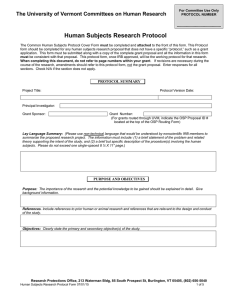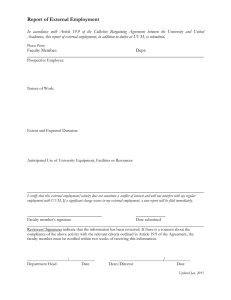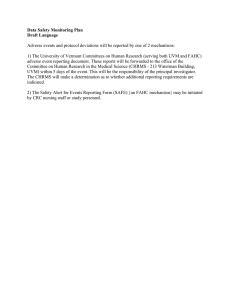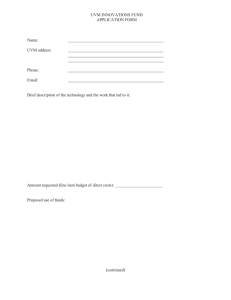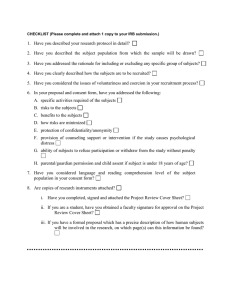Human Subjects Research Protocol
advertisement
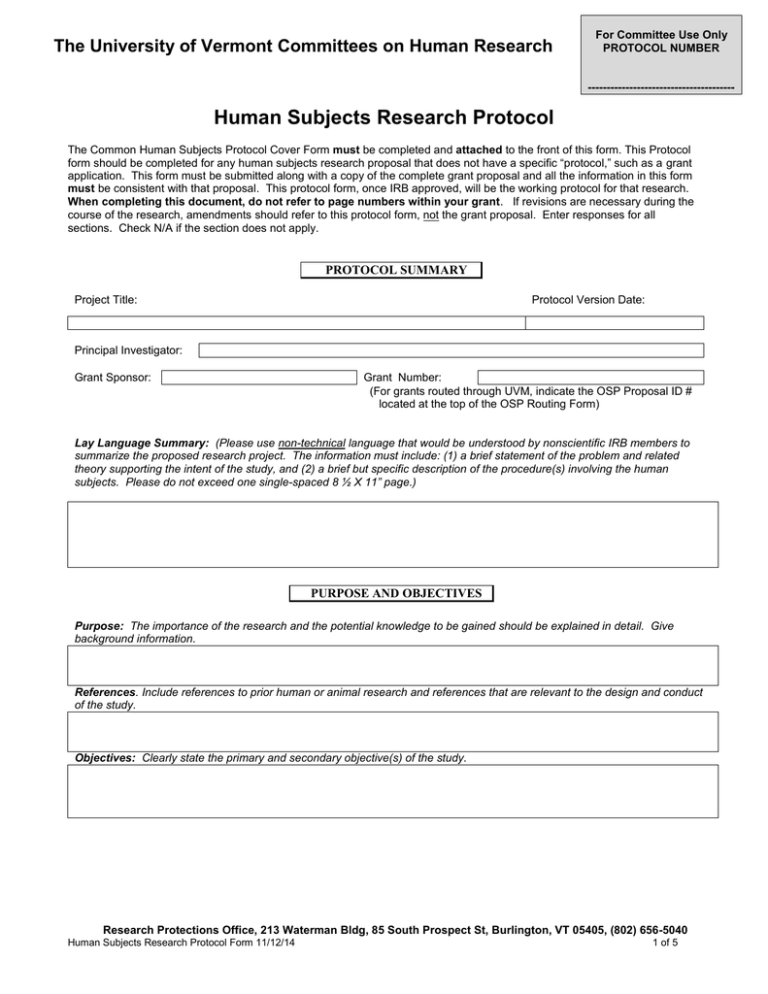
The University of Vermont Committees on Human Research For Committee Use Only PROTOCOL NUMBER --------------------------------------- Human Subjects Research Protocol The Common Human Subjects Protocol Cover Form must be completed and attached to the front of this form. This Protocol form should be completed for any human subjects research proposal that does not have a specific “protocol,” such as a grant application. This form must be submitted along with a copy of the complete grant proposal and all the information in this form must be consistent with that proposal. This protocol form, once IRB approved, will be the working protocol for that research. When completing this document, do not refer to page numbers within your grant. If revisions are necessary during the course of the research, amendments should refer to this protocol form, not the grant proposal. Enter responses for all sections. Check N/A if the section does not apply. PROTOCOL SUMMARY Project Title: Protocol Version Date: Principal Investigator: Grant Sponsor: Grant Number: (For grants routed through UVM, indicate the OSP Proposal ID # located at the top of the OSP Routing Form) Lay Language Summary: (Please use non-technical language that would be understood by nonscientific IRB members to summarize the proposed research project. The information must include: (1) a brief statement of the problem and related theory supporting the intent of the study, and (2) a brief but specific description of the procedure(s) involving the human subjects. Please do not exceed one single-spaced 8 ½ X 11” page.) PURPOSE AND OBJECTIVES Purpose: The importance of the research and the potential knowledge to be gained should be explained in detail. Give background information. References. Include references to prior human or animal research and references that are relevant to the design and conduct of the study. Objectives: Clearly state the primary and secondary objective(s) of the study. Research Protections Office, 213 Waterman Bldg, 85 South Prospect St, Burlington, VT 05405, (802) 656-5040 Human Subjects Research Protocol Form 11/12/14 1 of 5 METHODS AND PROCEDURES Study Design: Describe the research design, including a description of any new methodology and its advantage over existing methodologies. Procedures: Describe all procedures (sequentially) to which human participants will be subjected. Identify all procedures that are considered experimental and/or procedures performed exclusively for research purposes. Describe the types, frequency and duration of tests, study visits, interviews, questionnaires, etc. Include required screening procedures performed before enrollment and while on study. Please provide in table, list or outline format for ease of review. (describe and attach all instruments) Note: A clinical research protocol may involve interventions that are strictly experimental or it may involve some aspect of research (e.g., randomization among standard treatments for collection and analysis of routine clinical data for research purposes). It is important for this section to distinguish between interventions that are experimental and/or carried out for research purposes versus those procedures that are considered standard therapy. In addition, routine procedures performed solely for research purposes (e.g., additional diagnostic/follow-up tests) should be identified. For research involving survey, questionnaires, etc.: Describe the setting and the mode of administering the instrument and the provisions for maintaining privacy and confidentiality. Include the duration, intervals of administration, and overall length of participation. (describe and attach all instruments) Not applicable Statistical Considerations: Delineate the precise outcomes to be measured and analyzed. Describe how these results will be measured and statistically analyzed. Delineate methods used to estimate the required number of subjects. Describe power calculations if the study involves comparisons. Perform this analysis on each of the primary and secondary objectives, if possible. Confidentiality Measures and Secure Storage of Data or Tissue: Describe how the data/tissue will be collected. Will there be identifiers or will the data/tissue be coded? Describe where the data/tissue will be stored and how it will be secured. Describe who will have access to the data/tissue or the codes. If subject data/tissues with identifiers will be released, specify to whom. Describe what will happen to the data/tissues when the research has been completed. Not Applicable Risks/Benefits: Describe any potential or known risks. This includes physical, psychological, social, legal or other risks. Estimate the probability that given risk may occur, its severity and potential reversibility. If the study involves a placebo or washout period, the risks related to these must be addressed in both the protocol and consent. Describe the planned procedures for protecting against or minimizing potential risks and assess their likely effectiveness. Where appropriate, discuss plans for ensuring necessary medical or professional intervention in the event of adverse effects to the subjects. Discuss the potential benefits of the research to the subjects and others. Discuss why the risks to the subjects are reasonable in relation to the anticipated benefits to subjects and others. Discuss the importance of the knowledge gained or to be gained as a result of the proposed research and why the risks are reasonable in relation to the knowledge that reasonably may result. If there are no benefits state so. Therapeutic Alternatives: List the therapeutic alternatives that are reasonably available that may be of benefit to the potential subject and include in the consent form as well. Not Applicable Research Protections Office, 213 Waterman Bldg, 85 South Prospect St, Burlington, VT 05405, (802) 656-5040 Human Subjects Research Protocol Form 11/12/14 2 of 5 Data Safety and Monitoring: The specific design of a Data and Safety Monitoring Plan (DSMP) for a protocol may vary extensively depending on the potential risks, size, and complexity of the research study. For a minimal risk study, a DSMP could be as simple as a description of the Principal Investigator’s plan for monitoring the data and performance of safety reviews or it could be as complex as the initiation of an external, independent Data Safety and Monitoring Board (DSMB). The UVM/UVM Medical Center process for review of adverse events should be included in the DSMP. Adverse Event and Unanticipated Problem (UAP) Reporting: Describe how events and UAPs will be evaluated and reported to the IRB. All protocols should specify that, in the absence of more stringent reporting requirements, the guidelines established in the Committees on Human Research “Adverse Event and Unanticipated Problems Reporting Policy” will be followed. The UVM/UVM Medical Center process for review of adverse events and UAPs to subjects or others should be included in the DSMP. Withdrawal Procedures: Define the precise criteria for withdrawing subjects from the study. Include a description of study requirements for when a subject withdraws him or herself from the study (if applicable). Sources of Materials: Identify sources of research material obtained from individually identifiable human subjects in the form of specimens, records or data. Indicate whether the material or data will be obtained specifically for research purposes or whether use will be made of existing specimens, records or data. DRUG AND DEVICE INFORMATION Investigators are encouraged to consult the UVM Medical Center Investigational Pharmacy Drug Service (847-4863) prior to finalizing study drug/substance procedures. Drug (s) Not applicable Drug name – generic followed by brand name and common abbreviations. Availability – Source and pharmacology; vial or product sizes and supplier. If a placebo will be used, identify its contents and source. (attach investigational drug brochure) Preparation: Reconstitution instructions; preparation of a sterile product, compounded dosage form; mixing guidelines, including fluid and volume required. Identify who will prepare. Storage and stability – for both intact and mixed products. Administration – Describe acceptable routes and methods of administration and any associated risks of administration. Toxicity – Accurate but concise listings of major toxicities. Rare toxicities, which may be severe, should be included by indicated incidence. Also adverse interactions with other drugs used in the protocol regimen as well as specific foods should be noted. Address significant drug or drug/food interactions in the consent form as well. List all with above details. Is it FDA approved: (include FDA IND Number) 1. in the dosage form specified? If no, provide justification for proposed use and source of the study drug in that form. 2. for the route of administration specified? If no, provide justification for route and describe the method to accomplish. 3. for the intended action? Device (s) Not applicable Device name and indications (attach investigational device brochure) Is it FDA approved: (include FDA IDE Number) 1. for indication specified? If no, provide justification for proposed use and source of the device. Risk assessment (non-significant/significant risk) - PI or sponsor needs to assess risk of a device based upon the use of the device with human subjects in a research environment. Research Protections Office, 213 Waterman Bldg, 85 South Prospect St, Burlington, VT 05405, (802) 656-5040 Human Subjects Research Protocol Form 11/12/14 3 of 5 SUBJECT CHARACTERISTICS, IDENTIFICATION AND RECRUITMENT Subject Selection: Provide rationale for subject selection in terms of the scientific objectives and proposed study design. Vulnerable Populations: Explain the rationale for involvement of special classes of subjects, if any. Discuss what procedures or practices will be used in the protocol to minimize their susceptibility to undue influences and unnecessary risk (physical, psychological, etc.). Not applicable Number of Subjects: What is the anticipated number of subjects to be enrolled at UVM/UVM Medical Center and in the case of a multi-center study, with UVM/UVM Medical Center as the lead, the total number of subjects for the entire study. Inclusion/Exclusion Criteria: Eligibility and ineligibility criteria should be specific. Describe how eligibility will be determined and by whom. Changes to the eligibility criteria at a later phase of the research have the potential to invalidate the research. Inclusion of Minorities and Women: Describe efforts to include minorities and women. If either minorities or women are excluded, include a justification for the exclusion. Inclusion of Children: Describe efforts to include children. Inclusion is required unless a clear and compelling rationale shows that inclusion is inappropriate with respect to the health of the subjects or that inclusion is inappropriate for the purpose of the study. If children are included, the description of the plan should include a rationale for selecting or excluding a specific age range of children. When included, the plan must also describe the expertise of the investigative team in working with children, the appropriateness of the available facilities to accommodate children, and the inclusion of a sufficient number of children to contribute to a meaningful analysis relative to the purpose of the study. If children are excluded then provide appropriate justification. Provide target accrual for this population. For protocols including the use of an investigational drug, indicate whether women of childbearing potential have been included and, if not, include appropriate justification. If HIV testing is included specifically for research purposes explain how the test results will be protected against unauthorized disclosure. Include if the subjects are to be informed of the test results. If yes, include the process and provision for counseling. If no, a rationale for not informing the subjects should be included. Not applicable Recruitment: Describe plans for identifying and recruitment of subjects. All recruitment materials (flyers, ads, letters, etc) need to be IRB approved prior to use. FINANCIAL CONSIDERATIONS Expense to Subject: If the investigation involves the possibility of added expense to the subject (longer hospitalization, extra studies, etc.) indicate in detail how this will be handled. In cases where the FDA has authorized the drug or device company to charge the patient for the experimental drug or device, a copy of the authorization letter from the FDA or sponsor must accompany the application. Final approval will not be granted until the IRB receives this documentation. There are very limited circumstances under which study participants may be responsible (either directly or via their insurance) for covering some study-related expenses. If the study participant or their insurer(s) will be billed for any portion of the research study, provide a justification as to why this is appropriate and acceptable. For example, if the study involves treatment that is documented standard of care and not investigational, state so. In these cases, the protocol and the consent should clearly define what is standard of care and what is research. Payment for participation: Describe all plans to pay subjects, either in cash, a gift or gift certificate. Please note that all payments must be prorated throughout the life of the study. The IRB will not approve a study where there is only a lump sum payment at the end of the study because this can be considered coercive. The amount of payment must be justified. Clarify if subjects will be reimbursed for travel or other expenses. Not applicable Research Protections Office, 213 Waterman Bldg, 85 South Prospect St, Burlington, VT 05405, (802) 656-5040 Human Subjects Research Protocol Form 11/12/14 4 of 5 Collaborating Sites. When research involving human subjects will take place at collaborating sites or other performance sites when UVM/UVM Medical Center is the lead site, the principal investigator must provide in this section a list of the collaborating sites and their Federalwide Assurance numbers when applicable. (agreements may be necessary) Not applicable INFORMED CONSENT Consent Procedures: Describe the consent procedures to be followed, including the circumstances under which consent will be obtained, who will seek it, and the methods of documenting consent. Specify the form(s) that will be used e.g. consent (if multiple forms explain and place identifier on each form), assent form and/or HIPAA authorization (if PHI is included). These form(s) must accompany the protocol as an appendix or attachment. Note: Only those individuals authorized to solicit consent may sign the consent form confirming that the prospective subject was provided the necessary information and that any questions asked were answered. Information Withheld From Subjects: Will any information about the research purpose and design be withheld from potential or participating subjects? If so, explain and justify the non-disclosure and describe plans for post-study debriefing. Not applicable Attach full grant application, including budget information and/or any contract or draft contract associated with this application. Research Protections Office, 213 Waterman Bldg, 85 South Prospect St, Burlington, VT 05405, (802) 656-5040 Human Subjects Research Protocol Form 11/12/14 5 of 5
